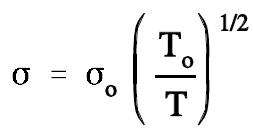
Effects of Temperature on Cross Section
 المؤلف:
U.S. Department of Commerce, National Technical Information Service, 1993
المؤلف:
U.S. Department of Commerce, National Technical Information Service, 1993
 المصدر:
The Nuclear Physics and Reactor Theory Handbook
المصدر:
The Nuclear Physics and Reactor Theory Handbook
 الجزء والصفحة:
...
الجزء والصفحة:
...
 5-4-2017
5-4-2017
 2232
2232
Effects of Temperature on Cross Section
As discussed, the microscopic absorption cross section varies significantly as neutron energy varies. The microscopic cross sections provided on most charts and tables are measured for a standard neutron velocity of 2200 meters/second, which corresponds to an ambient temperature of 68oF. Therefore, if our material is at a higher temperature, the absorption cross section will be lower than the value for 68(F, and any cross sections which involve absorption (for example, σa , σc , σf ) must be corrected for the existing temperature.
The following formula is used to correct microscopic cross sections for temperature. Although the example illustrates absorption cross section, the same formula may be used to correct capture and fission cross sections.

where:
σ = microscopic cross section corrected for temperature
σo = microscopic cross section at reference temperature (68oF or 20oC)
To = reference temperature (68oF) in degrees Rankine (oR) or Kelvin (oK)
T = temperature for which corrected value is being calculated
NOTE: When using this formula, all temperatures must be converted to oR or oK.
oR = oF + 460
oK = oC + 273
 الاكثر قراءة في مواضيع عامة في الفيزياء النووية
الاكثر قراءة في مواضيع عامة في الفيزياء النووية
 اخر الاخبار
اخر الاخبار
اخبار العتبة العباسية المقدسة


